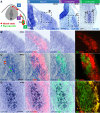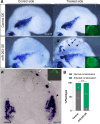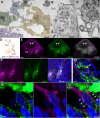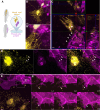miR-203 secreted in extracellular vesicles mediates the communication between neural crest and placode cells required for trigeminal ganglia formation
- PMID: 39038054
- PMCID: PMC11293684
- DOI: 10.1371/journal.pbio.3002074
miR-203 secreted in extracellular vesicles mediates the communication between neural crest and placode cells required for trigeminal ganglia formation
Abstract
While interactions between neural crest and placode cells are critical for the proper formation of the trigeminal ganglion, the mechanisms underlying this process remain largely uncharacterized. Here, by using chick embryos, we show that the microRNA (miR)-203, whose epigenetic repression is required for neural crest migration, is reactivated in coalescing and condensing trigeminal ganglion cells. Overexpression of miR-203 induces ectopic coalescence of neural crest cells and increases ganglion size. By employing cell-specific electroporations for either miR-203 sponging or genomic editing using CRISPR/Cas9, we elucidated that neural crest cells serve as the source, while placode cells serve as the site of action for miR-203 in trigeminal ganglion condensation. Demonstrating intercellular communication, overexpression of miR-203 in the neural crest in vitro or in vivo represses an miR-responsive sensor in placode cells. Moreover, neural crest-secreted extracellular vesicles (EVs), visualized using pHluorin-CD63 vector, become incorporated into the cytoplasm of placode cells. Finally, RT-PCR analysis shows that small EVs isolated from condensing trigeminal ganglia are selectively loaded with miR-203. Together, our findings reveal a critical role in vivo for neural crest-placode communication mediated by sEVs and their selective microRNA cargo for proper trigeminal ganglion formation.
Copyright: © 2024 Bernardi et al. This is an open access article distributed under the terms of the Creative Commons Attribution License, which permits unrestricted use, distribution, and reproduction in any medium, provided the original author and source are credited.
Conflict of interest statement
The authors have declared that no competing interests exist.
Figures







Update of
-
Extracellular vesicle-localized miR-203 mediates neural crest-placode communication required for trigeminal ganglia formation.bioRxiv [Preprint]. 2023 Mar 15:2023.03.14.532527. doi: 10.1101/2023.03.14.532527. bioRxiv. 2023. Update in: PLoS Biol. 2024 Jul 22;22(7):e3002074. doi: 10.1371/journal.pbio.3002074. PMID: 36993487 Free PMC article. Updated. Preprint.
References
MeSH terms
Substances
Grants and funding
LinkOut - more resources
Full Text Sources
Miscellaneous

